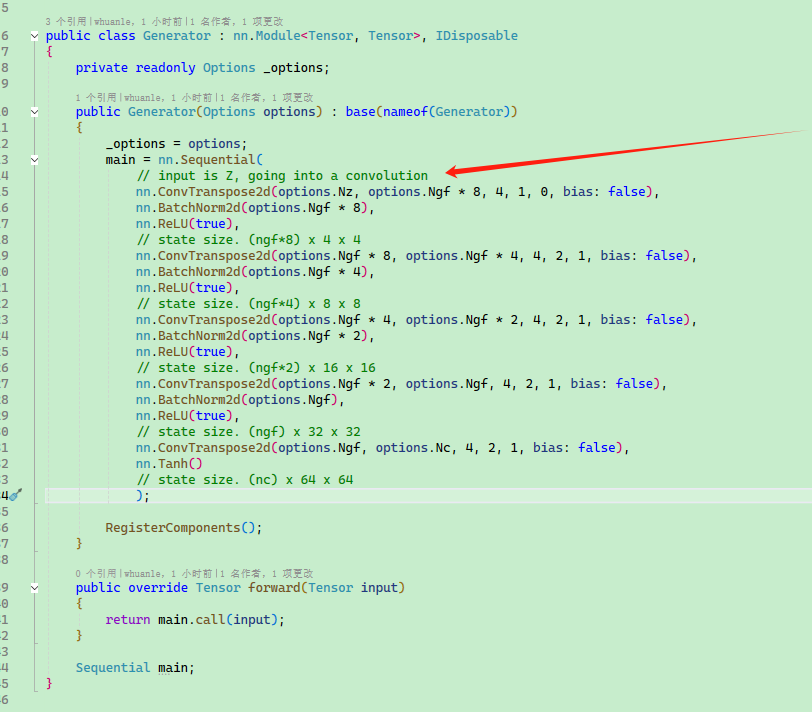pix2pix阅读及代码分析
原创
前言
最近在工作中要做一些关于图片简化的事情,也就是将复杂的A图转化成简单的B图,于是便想到了用GAN来做,而用GAN的话,怎么能绕过pix2pix这篇文章 借此机会开始分享一下咯
效果
pix2pix很好地实现了图像到图像之间的映射,效果非常惊艳、逼真
论文效果

更多效果
还有很多社区大神用pix2pix做的非常惊艳的demo,可以到 https://phillipi.github.io/pix2pix/ 欣赏

背景
pix2pix要解决什么问题
- 像素到像素的预测任务,比如mask转街景、mask转门脸、黑白图转彩色图等在pix2pix出现以前都是单一、割裂的解决方案,没有一个通用的框架
- CNN利用最小化欧氏距离以减少预测像素与ground truth像素之间的差异,很容易导致生成的图片都是模糊的,即生成的图片倾向于"不犯错"而丢失了真实图片中的边缘信息等
pix2pix怎么解决问题的
- 利用条件GAN作为解决像素到像素预测任务的通用框架
- GAN能够学习loss,使得在对输出图片进行real还是fake分类的同时还能训练生成模型最小化这个loss,从而使得模糊图片会被判别为fake
方法
模型结构
生成器
U-Net,利用skip-connection能够让低维信息在输入和输出之间共享,使得其图像转译过程中不会丢失

判别器
PatchGAN 本质上是个多层全连接层,先将生成器输出的图片切分成NN个patch(N远小于图片大小,采用NN个patch的话,不仅可以使PatchGAN参数更少,运行更快还能应用于任意大的图片),对NN个patch进行real还是fake的二分类判断,最后将NN个patch的分类score进行平均得到整张图片的分类score PatchGAN将图片看作为马尔科夫随机场,假设不同patch之间的像素是相互独立的
损失函数
其中,
评价指标
Frechet Inception Distance(FID)考虑的是生成图像与真实图像之间的联系 用同样数目的生成图像和真实图像各N张,用Inception提取图片的特征(2048维的向量)计算N*2048维的特征向量之间的距离
其中和 分别代表生成图像和真实图像,和 表示其对应图像的特征向量,和 表示其对应特征向量的协方差矩阵,表示矩阵的迹(主对角线各元素的和)。特征向量之间的距离越近表示生成模型的效果越好,生成的图像清晰度越高
代码分析
构建模型
if self.isTrain:
self.model_names = ['G', 'D']
else: # during test time, only load G
self.model_names = ['G']# input_nc, num of input image channels: 3 for RGB and 1 for grayscale
# output_nc, num of output image channels: 3 for RGB and 1 for grayscale
# ngf, num of gen filters in the last conv layer
# netG, specify generator architecture [unet_256 | unet_128]
# norm, instance normalization or batch normalization [instance | batch | none]
# no_dropout, no dropout for the generator
# init_type, network initialization [normal | xavier | kaiming | orthogonal]
# init_gain, scaling factor for normal, xavier and orthogonal, default=0.2
self.netG = networks.define_G(opt.input_nc, opt.output_nc, opt.ngf, opt.netG, opt.norm, not opt.no_dropout, opt.init_type, opt.init_gain, self.gpu_ids)def define_G(input_nc, output_nc, ngf, netG, norm='batch', use_dropout=False, init_type='normal', init_gain=0.02, gpu_ids=[]):
"""Create a generator
Parameters:
input_nc (int) -- the number of channels in input images
output_nc (int) -- the number of channels in output images
ngf (int) -- the number of filters in the last conv layer
netG (str) -- the architecture's name: resnet_9blocks | resnet_6blocks | unet_256 | unet_128
norm (str) -- the name of normalization layers used in the network: batch | instance | none
use_dropout (bool) -- if use dropout layers.
init_type (str) -- the name of our initialization method.
init_gain (float) -- scaling factor for normal, xavier and orthogonal.
gpu_ids (int list) -- which GPUs the network runs on: e.g., 0,1,2
Returns a generator
"""
net = None
norm_layer = get_norm_layer(norm_type=norm)
if netG == 'resnet_9blocks':
net = ResnetGenerator(input_nc, output_nc, ngf, norm_layer=norm_layer, use_dropout=use_dropout, n_blocks=9)
elif netG == 'resnet_6blocks':
net = ResnetGenerator(input_nc, output_nc, ngf, norm_layer=norm_layer, use_dropout=use_dropout, n_blocks=6)
elif netG == 'unet_128':
net = UnetGenerator(input_nc, output_nc, 7, ngf, norm_layer=norm_layer, use_dropout=use_dropout)
elif netG == 'unet_256':
net = UnetGenerator(input_nc, output_nc, 8, ngf, norm_layer=norm_layer, use_dropout=use_dropout)
else:
raise NotImplementedError('Generator model name [%s] is not recognized' % netG)
return init_net(net, init_type, init_gain, gpu_ids)class UnetGenerator(nn.Module):
"""Create a Unet-based generator"""
def __init__(self, input_nc, output_nc, num_downs, ngf=64, norm_layer=nn.BatchNorm2d, use_dropout=False):
"""Construct a Unet generator
Parameters:
input_nc (int) -- the number of channels in input images
output_nc (int) -- the number of channels in output images
num_downs (int) -- the number of downsamplings in UNet. For example, # if |num_downs| == 7,
image of size 128x128 will become of size 1x1 # at the bottleneck
ngf (int) -- the number of filters in the last conv layer
norm_layer -- normalization layer
We construct the U-Net from the innermost layer to the outermost layer.
It is a recursive process.
"""
super(UnetGenerator, self).__init__()
# construct unet structure
unet_block = UnetSkipConnectionBlock(ngf * 8, ngf * 8, input_nc=None, submodule=None, norm_layer=norm_layer, innermost=True) # add the innermost layer
for i in range(num_downs - 5): # add intermediate layers with ngf * 8 filters
unet_block = UnetSkipConnectionBlock(ngf * 8, ngf * 8, input_nc=None, submodule=unet_block, norm_layer=norm_layer, use_dropout=use_dropout)
# gradually reduce the number of filters from ngf * 8 to ngf
unet_block = UnetSkipConnectionBlock(ngf * 4, ngf * 8, input_nc=None, submodule=unet_block, norm_layer=norm_layer)
unet_block = UnetSkipConnectionBlock(ngf * 2, ngf * 4, input_nc=None, submodule=unet_block, norm_layer=norm_layer)
unet_block = UnetSkipConnectionBlock(ngf, ngf * 2, input_nc=None, submodule=unet_block, norm_layer=norm_layer)
self.model = UnetSkipConnectionBlock(output_nc, ngf, input_nc=input_nc, submodule=unet_block, outermost=True, norm_layer=norm_layer) # add the outermost layer
def forward(self, input):
"""Standard forward"""
return self.model(input)class UnetSkipConnectionBlock(nn.Module):
"""Defines the Unet submodule with skip connection.
X -------------------identity----------------------
|-- downsampling -- |submodule| -- upsampling --|
"""
def __init__(self, outer_nc, inner_nc, input_nc=None,
submodule=None, outermost=False, innermost=False, norm_layer=nn.BatchNorm2d, use_dropout=False):
"""Construct a Unet submodule with skip connections.
Parameters:
outer_nc (int) -- the number of filters in the outer conv layer
inner_nc (int) -- the number of filters in the inner conv layer
input_nc (int) -- the number of channels in input images/features
submodule (UnetSkipConnectionBlock) -- previously defined submodules
outermost (bool) -- if this module is the outermost module
innermost (bool) -- if this module is the innermost module
norm_layer -- normalization layer
use_dropout (bool) -- if use dropout layers.
"""
super(UnetSkipConnectionBlock, self).__init__()
self.outermost = outermost
if type(norm_layer) == functools.partial:
use_bias = norm_layer.func == nn.InstanceNorm2d
else:
use_bias = norm_layer == nn.InstanceNorm2d
if input_nc is None:
input_nc = outer_nc
downconv = nn.Conv2d(input_nc, inner_nc, kernel_size=4,
stride=2, padding=1, bias=use_bias)
downrelu = nn.LeakyReLU(0.2, True)
downnorm = norm_layer(inner_nc)
uprelu = nn.ReLU(True)
upnorm = norm_layer(outer_nc)
if outermost:
upconv = nn.ConvTranspose2d(inner_nc * 2, outer_nc,
kernel_size=4, stride=2,
padding=1)
down = [downconv]
up = [uprelu, upconv, nn.Tanh()]
model = down + [submodule] + up
elif innermost:
upconv = nn.ConvTranspose2d(inner_nc, outer_nc,
kernel_size=4, stride=2,
padding=1, bias=use_bias)
down = [downrelu, downconv]
up = [uprelu, upconv, upnorm]
model = down + up
else:
upconv = nn.ConvTranspose2d(inner_nc * 2, outer_nc,
kernel_size=4, stride=2,
padding=1, bias=use_bias)
down = [downrelu, downconv, downnorm]
up = [uprelu, upconv, upnorm]
if use_dropout:
model = down + [submodule] + up + [nn.Dropout(0.5)]
else:
model = down + [submodule] + up
self.model = nn.Sequential(*model)
def forward(self, x):
if self.outermost:
return self.model(x)
else: # add skip connections
return torch.cat([x, self.model(x)], 1)def define_D(input_nc, ndf, netD, n_layers_D=3, norm='batch', init_type='normal', init_gain=0.02, gpu_ids=[]):
"""Create a discriminator
Parameters:
input_nc (int) -- the number of channels in input images
ndf (int) -- the number of filters in the first conv layer
netD (str) -- the architecture's name: basic | n_layers | pixel
n_layers_D (int) -- the number of conv layers in the discriminator; effective when netD=='n_layers'
norm (str) -- the type of normalization layers used in the network.
init_type (str) -- the name of the initialization method.
init_gain (float) -- scaling factor for normal, xavier and orthogonal.
gpu_ids (int list) -- which GPUs the network runs on: e.g., 0,1,2
Returns a discriminator
Our current implementation provides three types of discriminators:
[basic]: 'PatchGAN' classifier described in the original pix2pix paper.
It can classify whether 70×70 overlapping patches are real or fake.
Such a patch-level discriminator architecture has fewer parameters
than a full-image discriminator and can work on arbitrarily-sized images
in a fully convolutional fashion.
[n_layers]: With this mode, you can specify the number of conv layers in the discriminator
with the parameter <n_layers_D> (default=3 as used in [basic] (PatchGAN).)
[pixel]: 1x1 PixelGAN discriminator can classify whether a pixel is real or not.
It encourages greater color diversity but has no effect on spatial statistics.
The discriminator has been initialized by <init_net>. It uses Leakly RELU for non-linearity.
"""
net = None
norm_layer = get_norm_layer(norm_type=norm)
if netD == 'basic': # default PatchGAN classifier
net = NLayerDiscriminator(input_nc, ndf, n_layers=3, norm_layer=norm_layer)
elif netD == 'n_layers': # more options
net = NLayerDiscriminator(input_nc, ndf, n_layers_D, norm_layer=norm_layer)
elif netD == 'pixel': # classify if each pixel is real or fake
net = PixelDiscriminator(input_nc, ndf, norm_layer=norm_layer)
else:
raise NotImplementedError('Discriminator model name [%s] is not recognized' % netD)
return init_net(net, init_type, init_gain, gpu_ids)class NLayerDiscriminator(nn.Module):
"""Defines a PatchGAN discriminator"""
def __init__(self, input_nc, ndf=64, n_layers=3, norm_layer=nn.BatchNorm2d):
"""Construct a PatchGAN discriminator
Parameters:
input_nc (int) -- the number of channels in input images
ndf (int) -- the number of filters in the last conv layer
n_layers (int) -- the number of conv layers in the discriminator
norm_layer -- normalization layer
"""
super(NLayerDiscriminator, self).__init__()
if type(norm_layer) == functools.partial: # no need to use bias as BatchNorm2d has affine parameters
use_bias = norm_layer.func == nn.InstanceNorm2d
else:
use_bias = norm_layer == nn.InstanceNorm2d
kw = 4
padw = 1
sequence = [nn.Conv2d(input_nc, ndf, kernel_size=kw, stride=2, padding=padw), nn.LeakyReLU(0.2, True)]
nf_mult = 1
nf_mult_prev = 1
for n in range(1, n_layers): # gradually increase the number of filters
nf_mult_prev = nf_mult
nf_mult = min(2 ** n, 8)
sequence += [
nn.Conv2d(ndf * nf_mult_prev, ndf * nf_mult, kernel_size=kw, stride=2, padding=padw, bias=use_bias),
norm_layer(ndf * nf_mult),
nn.LeakyReLU(0.2, True)
]
nf_mult_prev = nf_mult
nf_mult = min(2 ** n_layers, 8)
sequence += [
nn.Conv2d(ndf * nf_mult_prev, ndf * nf_mult, kernel_size=kw, stride=1, padding=padw, bias=use_bias),
norm_layer(ndf * nf_mult),
nn.LeakyReLU(0.2, True)
]
sequence += [nn.Conv2d(ndf * nf_mult, 1, kernel_size=kw, stride=1, padding=padw)] # output 1 channel prediction map
self.model = nn.Sequential(*sequence)
def forward(self, input):
"""Standard forward."""
return self.model(input)class PixelDiscriminator(nn.Module):
"""Defines a 1x1 PatchGAN discriminator (pixelGAN)"""
def __init__(self, input_nc, ndf=64, norm_layer=nn.BatchNorm2d):
"""Construct a 1x1 PatchGAN discriminator
Parameters:
input_nc (int) -- the number of channels in input images
ndf (int) -- the number of filters in the last conv layer
norm_layer -- normalization layer
"""
super(PixelDiscriminator, self).__init__()
if type(norm_layer) == functools.partial: # no need to use bias as BatchNorm2d has affine parameters
use_bias = norm_layer.func == nn.InstanceNorm2d
else:
use_bias = norm_layer == nn.InstanceNorm2d
self.net = [
nn.Conv2d(input_nc, ndf, kernel_size=1, stride=1, padding=0),
nn.LeakyReLU(0.2, True),
nn.Conv2d(ndf, ndf * 2, kernel_size=1, stride=1, padding=0, bias=use_bias),
norm_layer(ndf * 2),
nn.LeakyReLU(0.2, True),
nn.Conv2d(ndf * 2, 1, kernel_size=1, stride=1, padding=0, bias=use_bias)]
self.net = nn.Sequential(*self.net)
def forward(self, input):
"""Standard forward.""
return self.net(input)loss函数
self.criterionGAN = networks.GANLoss(opt.gan_mode).to(self.device)
self.criterionL1 = torch.nn.L1Loss()
class GANLoss(nn.Module):
"""Define different GAN objectives.
The GANLoss class abstracts away the need to create the target label tensor
that has the same size as the input.
"""
def __init__(self, gan_mode, target_real_label=1.0, target_fake_label=0.0):
""" Initialize the GANLoss class.
Parameters:
gan_mode (str) - - the type of GAN objective. It currently supports vanilla, lsgan, and wgangp.
target_real_label (bool) - - label for a real image
target_fake_label (bool) - - label of a fake image
Note: Do not use sigmoid as the last layer of Discriminator.
LSGAN needs no sigmoid. vanilla GANs will handle it with BCEWithLogitsLoss.
"""
super(GANLoss, self).__init__()
self.register_buffer('real_label', torch.tensor(target_real_label))
self.register_buffer('fake_label', torch.tensor(target_fake_label))
self.gan_mode = gan_mode
if gan_mode == 'lsgan':
self.loss = nn.MSELoss()
elif gan_mode == 'vanilla':
self.loss = nn.BCEWithLogitsLoss()
elif gan_mode in ['wgangp']:
self.loss = None
else:
raise NotImplementedError('gan mode %s not implemented' % gan_mode)网络参数更新
def optimize_parameters(self):
self.forward() # compute fake images: G(A)
# update D
self.set_requires_grad(self.netD, True) # enable backprop for D
self.optimizer_D.zero_grad() # set D's gradients to zero
self.backward_D() # calculate gradients for D
self.optimizer_D.step() # update D's weights
# update G
self.set_requires_grad(self.netD, False) # D requires no gradients when optimizing G
self.optimizer_G.zero_grad() # set G's gradients to zero
self.backward_G() # calculate graidents for G
self.optimizer_G.step() # udpate G's weights
def forward(self):
"""Run forward pass; called by both functions <optimize_parameters> and <test>."""
self.fake_B = self.netG(self.real_A) # G(A)
def backward_D(self):
"""Calculate GAN loss for the discriminator"""
# Fake; stop backprop to the generator by detaching fake_B
fake_AB = torch.cat((self.real_A, self.fake_B), 1) # we use conditional GANs; we need to feed both input and output to the discriminator
pred_fake = self.netD(fake_AB.detach())
self.loss_D_fake = self.criterionGAN(pred_fake, False)
# Real
real_AB = torch.cat((self.real_A, self.real_B), 1)
pred_real = self.netD(real_AB)
self.loss_D_real = self.criterionGAN(pred_real, True)
# combine loss and calculate gradients
self.loss_D = (self.loss_D_fake + self.loss_D_real) * 0.5
self.loss_D.backward()
def backward_G(self):
"""Calculate GAN and L1 loss for the generator"""
# First, G(A) should fake the discriminator
fake_AB = torch.cat((self.real_A, self.fake_B), 1)
pred_fake = self.netD(fake_AB)
self.loss_G_GAN = self.criterionGAN(pred_fake, True)
# Second, G(A) = B
self.loss_G_L1 = self.criterionL1(self.fake_B, self.real_B) * self.opt.lambda_L1
# combine loss and calculate gradients
self.loss_G = self.loss_G_GAN + self.loss_G_L1
self.loss_G.backward()FID计算
# https://github.com/rosinality/stylegan2-pytorch/blob/master/fid.py
def calc_fid(sample_mean, sample_cov, real_mean, real_cov, eps=1e-6):
"""
sample_mean = np.mean(features, 0)
# Estimate a covariance matrix, given data and weights.
sample_cov = np.cov(features, rowvar=False)
with open(args.inception, "rb") as f:
embeds = pickle.load(f)
real_mean = embeds["mean"]
real_cov = embeds["cov"]
"""
# @ 中缀运算符,可进行矩阵乘法
cov_sqrt, _ = linalg.sqrtm(sample_cov @ real_cov, disp=False)
if not np.isfinite(cov_sqrt).all():
print("product of cov matrices is singular")
offset = np.eye(sample_cov.shape[0]) * eps
cov_sqrt = linalg.sqrtm((sample_cov + offset) @ (real_cov + offset))
if np.iscomplexobj(cov_sqrt):
if not np.allclose(np.diagonal(cov_sqrt).imag, 0, atol=1e-3):
m = np.max(np.abs(cov_sqrt.imag))
raise ValueError(f"Imaginary component {m}")
cov_sqrt = cov_sqrt.real
mean_diff = sample_mean - real_mean
mean_norm = mean_diff @ mean_diff
trace = np.trace(sample_cov) + np.trace(real_cov) - 2 * np.trace(cov_sqrt)
fid = mean_norm + trace
return fid结论
pix2pix是一种条件GAN,能够很好地胜任image-to-image的转译任务,尤其是高度结构化的图形结构任务
参考
- pix2pix论文 https://arxiv.org/abs/1611.07004
- pix2pix torch版代码 https://github.com/junyanz/pytorch-CycleGAN-and-pix2pix
- pix2pix2 体验demo https://phillipi.github.io/pix2pix/
原创声明:本文系作者授权腾讯云开发者社区发表,未经许可,不得转载。
如有侵权,请联系 cloudcommunity@tencent.com 删除。
原创声明:本文系作者授权腾讯云开发者社区发表,未经许可,不得转载。
如有侵权,请联系 cloudcommunity@tencent.com 删除。





















